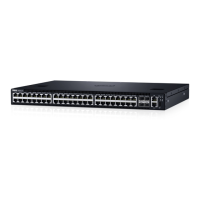• If the interface to be shut down is a port channel, all the member ports are disabled in the hardware.
• When you add a physical port to a port channel already in the Error Disable state, the new member port is also disabled in the
hardware.
• When you remove a physical port from a port channel in the Error Disable state, the error disabled state is cleared on this physical
port (the physical port is enabled in the hardware).
• You can clear the Error Disabled state with any of the following methods:
• Use the shutdown command on the interface.
• Disable the shutdown-on-violation command on the interface (using the no spanning-tree stp-id portfast
[bpduguard | [shutdown-on-violation]]
command).
• Disable spanning tree on the interface (using the no spanning-tree command in INTERFACE mode).
• Disabling global spanning tree (using the no spanning-tree command in CONFIGURATION mode).
Example of Enabling an EdgePort on an Interface
To verify that EdgePort is enabled, use the show config command from INTERFACE mode.
Dell(conf-if-gi-3/11)#spanning-tree mstp edge-port
Dell(conf-if-gi-3/11)#show config
!
interface GigabitEthernet 3/11
no ip address
switchport
spanning-tree mstp edge-port
spanning-tree MSTI 1 priority 144
no shutdown
Dell(conf-if-gi-3/11)#
Flush MAC Addresses after a Topology Change
Dell Networking OS has an optimized MAC address ush mechanism for RSTP, MSTP, and PVST+ that ushes addresses only when
necessary, which allows for faster convergence during topology changes.
However, you may activate the ushing mechanism dened by 802.1Q-2003 using the tc-flush-standard command, which ushes
MAC addresses after every topology change notication.
To view the enable status of this feature, use the show running-config spanning-tree mstp command from EXEC Privilege
mode.
MSTP Sample Congurations
The running-congurations support the topology shown in the following illustration.
The congurations are from Dell Networking OS systems.
Multiple Spanning Tree Protocol (MSTP)
505

